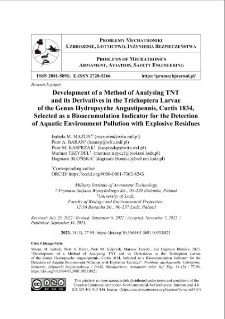Nasza Biblioteka Cyfrowa udostępnia 1 868 obiektów cyfrowych
Obiekt
Tytuł: Development of a Method of Analysing TNT and its Derivatives in the Trichoptera Larvae of the Genus Hydropsyche Angustipennis, Curtis 1834, Selected as a Bioaccumulation Indicator for the Detection of Aquatic Environment Pollution with Explosive Residues ; Development of a Method of Analysing TNT and its Derivatives in the Trichoptera Larvae of the Genus Hydropsyche Angustipennis, Curtis 1834, Selected as a Bioaccumulation Indicator for the Detection of Aquatic Environment Pollution with Explosive Residues
Tytuł odmienny:
Opracowanie metody analizy trotylu oraz jego pochodnych w larwach chruścików z gatunku wodosówka potokowa (Hydropsyche angustipennis, Curtis 1834) typowanego jako biowskaźnik akumulacji do wykrywania zanieczyszczenia środowiska wodnego pozostałościami po materiałach wybuchowych ; Opracowanie metody analizy trotylu oraz jego pochodnych w larwach chruścików z gatunku wodosówka potokowa (Hydropsyche angustipennis, Curtis 1834) typowanego jako biowskaźnik akumulacji do wykrywania zanieczyszczenia środowiska wodnego pozostałościami po materiałach wybuchowych
Współtwórca:
Piotr A. BARAN, Piotr M. KASPRZAK, Mariusz TSZYDEL, Dagmara BŁOŃSKA ; Piotr A. BARAN, Piotr M. KASPRZAK, Mariusz TSZYDEL, Dagmara BŁOŃSKA
Abstrakt:
Threats associated with the production, storage and use of warfare agents containing high explosives against the backdrop of political and social events emerging in the 21st century present new challenges for specialized laboratories involved in detecting contamination and identifying its source. A common analytical problem in studies conducted in the ecosystem is the low concentration of the test substance – below the detection limit of the instrument. Helpful in solving this dilemma are accumulation bio-markers, which appear to be an excellent tool for detecting contamination in, for example, flowing water. Such biomarkers make it possible to determine the presence of specific chemical agents at the same time they are a sensitive indicator of the ecosystem's response to contamination. The presented chromatographic method allows quantitative and qualitative determination of 2,6-diamino-4-nitrotoluene, 2,4-diamino-6- nitrotoluene, 1,3,5-trinitrobenzene, trinitrotoluene, 2-amino-4,6-dinitrotoluene, 4-amino-2,6-dinitrotoluene and tetryl in the biological matrix. The effects of accumulation in the tissue of crustaceans on TNT test solutions were studied from 1 to 24 hours. The saturation effect was observed and the concentration of TNT derivatives was measured. The observed effects confirmed the usefulness of the selected larva as a bio-indicator of TNT contaminant accumulation in the ecosystem.
;
Threats associated with the production, storage and use of warfare agents containing high explosives against the backdrop of political and social events emerging in the 21st century present new challenges for specialized laboratories involved in detecting contamination and identifying its source. A common analytical problem in studies conducted in the ecosystem is the low concentration of the test substance – below the detection limit of the instrument. Helpful in solving this dilemma are accumulation bio-markers, which appear to be an excellent tool for detecting contamination in, for example, flowing water. Such biomarkers make it possible to determine the presence of specific chemical agents at the same time they are a sensitive indicator of the ecosystem's response to contamination. The presented chromatographic method allows quantitative and qualitative determination of 2,6-diamino-4-nitrotoluene, 2,4-diamino-6- nitrotoluene, 1,3,5-trinitrobenzene, trinitrotoluene, 2-amino-4,6-dinitrotoluene, 4-amino-2,6-dinitrotoluene and tetryl in the biological matrix. The effects of accumulation in the tissue of crustaceans on TNT test solutions were studied from 1 to 24 hours. The saturation effect was observed and the concentration of TNT derivatives was measured. The observed effects confirmed the usefulness of the selected larva as a bio-indicator of TNT contaminant accumulation in the ecosystem.
Miejsce wydania:
Warszawa
;
Warszawa
Wydawca:
Wojskowa Akademia Techniczna ; Wojskowa Akademia Techniczna
Data utworzenia:
Data złożenia:
Data akceptacji:
Data wydania:
Rozmiar:
Identyfikator:
oai:ribes-88.man.poznan.pl:2682
Sygnatura:
doi:10.5604/01.3001.0053.8821 ; doi:10.5604/01.3001.0053.8821
ISSN elektroniczny:
ISSN drukowany:
Język:
Licencja:
kliknij tutaj, żeby przejść ; kliknij tutaj, żeby przejść
Właściciel praw:
Wojskowa Akademia Techniczna ; Wojskowa Akademia Techniczna
Strona początkowa:
Strona końcowa:
Tom:
Czasopismo:
Słowa kluczowe:
security, contamination, HPLC, TNT, bio-indicator ; security, contamination, HPLC, TNT, bio-indicator
Kolekcje, do których przypisany jest obiekt:
Data ostatniej modyfikacji:
15 paź 2025
Data dodania obiektu:
15 paź 2025
Liczba wyświetleń treści obiektu:
0
Wszystkie dostępne wersje tego obiektu:
https://ribes-88.man.poznan.pl/publication/3015

